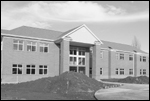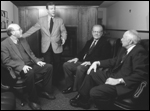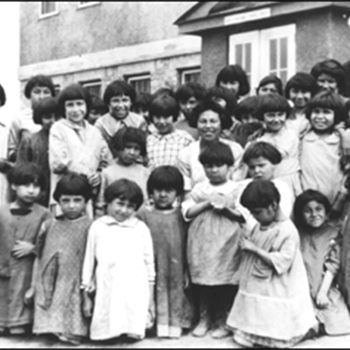Western Seminary and Multnomah Biblical Seminary are both conservative evangelical schools based in Portland, Oregon. In fact they are less than three miles apart. However, the incautious visitor going from one to the other without precise directions doesn’t immediately realize how close they are because of the many potential twists and turns, one-way streets, dead-ends and unexpected jogs one may encounter along the route. That cartographic quandary is an apt metaphor for dialogues the seminaries have been having on closer collaboration, possibly even merger. They’re friendly and collegial; they’ve been talking on and off for a long time; they have each formed clearer pictures of themselves and each other—but significant questions about further cooperation remain to be answered.
Western Seminary, historically associated with the Conservative Baptists, is seventy-five years old. Like many schools, it has had its ups and downs over the years, especially in terms of finances and student body size. It is currently in a stable and improving situation on both counts, with an enrollment of some 350. “Trans-denominational” Multnomah is a younger school, having opened its doors as a full-fledged graduate seminary in 1986. It is linked with Multnomah Bible College, founded in 1936. The seminary is growing, but the college is still the larger of the two deeply entwined schools that occupy the same campus and share a library, dining hall, and many other resources.
|
|
|
Conversation, deliberation and exploration have characterized the talks among (from left) Randal R. Roberts, academic dean of Western Seminary, Daniel R. Lockwood, president of Multnomah Biblical Seminary, Donald R. Brake, Multnomah dean, and Bert E. Downs, Western president.
Photograph by
|
As far back as the 1970s, before Multnomah established its seminary, administrators from Western and the Bible college held several sets of conversations about closer cooperation. The reasons for these talks, according to current executives at both schools, seemed obvious, beginning with geographical proximity. More important, though, says Daniel R. Lockwood, Multnomah’s president, “We have similar doctrines.” In fact, the schools’ mission statements could almost fit in each other’s catalogues. So, according to Bert E. Downs, president of Western, “it was a natural direction [for earlier leaders] to hold dialogues about cooperation.” (George Fox Seminary is another evangelical theological school in Portland, but it serves students primarily from the Wesleyan Methodist tradition rather than those from the Reformed Baptist tradition.)
At several points, those early conversations moved toward agreement, only to be put on hold by one or another development. Some of these interruptions were as identifiable as temporary financial problems for either school. Others were based on disagreements about structure and governance. Still others were less clear and probably based on deeper questions the conversations had not yet addressed.
Resuming the Discussion
With a change in both administrations in the late 1990s, the dialogue picked up again and became regular. Downs (who had been a student at Multnomah Bible College) was a Western faculty member and administrator from 1982 to1992. He left and then came back to assume the presidency in 1999. At Multnomah, Lockwood is president of both the college and the seminary. He began as a faculty member in 1979, later moving into administration and assuming the presidency in 1997. Both presidents consider it crucial to keep the conversation going, and they have met monthly for about a year and a half, with the talks coming to include deans of both schools.
Having already established their doctrinal compatibility, according to Downs, they began to ask, “Does the Pacific Northwest, among the least churched areas in the country, really need two evangelical seminaries of the same tradition?” Both schools say they don’t want to be competitors. Observed Downs, “We could compete each other into mediocrity.” According to Lockwood, both institutions draw on the same constituencies for potential students. Though Multnomah is non-denominational, both schools enroll approximately the same number of Conservative Baptists. Both faculties have trained at some of the same seminaries and universities. Many Portland-area supporters make donations to both schools.
The presidents’ and deans’ conversations have ranged all the way from comprehensive cross-registration of courses, to a joint web site and placement service, to sharing a pool of adjunct faculty, to possible full-fledged merger. Other segments of the two communities, including some faculty, staff, and board members, have met to discuss the same issues on a more informal and less regular basis.
Covering All the Bases
There have been many obvious questions to address, including the current and long-range financial condition of each institution. Would it strengthen rather than burden the other partner? Recently the schools have gone so far as to have financial administrators meet to talk in some detail, and they have opened their books to each other. At this point, finances do not seem to be a major issue, though the respective boards will be analyzing them further.
There is also the matter of structure and governance, potentially one of the most significant stumbling blocks for any collaboration. Administrative staff at both institutions are displaying a spirit of flexibility and compromise. In some cases, where job loss could result, anxiety is moderated by the approaching retirement age of several key players at both schools. They might be willing to leave early. With regard to faculty, administrators regard their respective sets of professors as essentially complementary. Thus they forecast that a merger would probably eliminate no faculty positions.
 |
|
Multnomah’s new seminary building, Travis-Lovitt Hall, was dedicated in January and may become a centerpiece of a combined school—the “M” for Multnomah being easily viewed as a “W” for Western depending on your perspective.
Photograph by
|
Questions of location and space, which could also stymie discussion, are of less importance in this case than they might be in others. Western’s buildings are parts of what used to be an estate: a large frame house with several smaller buildings. The school’s charming residential appearance is ironic. There’s no room for anyone to actually live on campus, and no place to expand into the surrounding, entirely residential, neighborhood. Further, the buildings are beginning to need major repairs. But there is not a lot of logic to making those repairs when Western needs more space anyway. It is generally assumed that any move would bring Western to Multnomah’s larger campus.
According to Donald L. Brake, Multnomah college’s vice president and seminary dean, a merger would solve Western’s space problems and improve already healthy finances for both schools. “They [Western] could sell their property, probably for $5 to $7 million, and move to our campus. A new institution could use that income for a variety of purposes extremely advantageous to both partners,” Brake pointed out. And because both schools are currently in good fiscal shape, none of the proceeds from such a sale would have to go toward plugging financial leaks somewhere. “Both schools would be merging from strength,” he said.
Student body size is another consideration. The principal actors recognize that a merger could produce a seminary population of at least 500, which could allow for such improvements as increased curricular variety. Brake pointed out, “Classes of five to ten students are not really financially viable,” and merger, or even more cross-registration, would yield enough students to fill more classes. (Western also has several branch campuses and learning centers on the West Coast, but students would remain at those locations and the size of the Portland community would be unaffected. The same is true of Western’s distance learning program.)
A Bump in the Road
On all of these topics, there would be many details to iron out, but the conversation partners do not see any of them as impossible hurdles. There is, however, one issue that is a persistent stumbling block, and, in a way, has become more nettlesome as participants have probed it more deeply. This is the ambiguous and slippery matter of the schools’ “cultural identities.” It is easy to overlook this factor when focusing on such specifics and tangibles as structure, governance, finances, or space, but all parties agree that it could cause major problems later if not resolved.
Some of those involved explicitly use the term “culture,” while others mean the same thing when they talk about “identity,” “sense of community,” “ambiance,” “atmosphere,” even “attitude.” In most cases, people are hard put to provide a precise definition of what they mean, but they know it when they see it, and it has great significance for them.
The theme is especially important at Multnomah because if it were to join with Western, the new seminary would be larger than Multnomah Bible College, whose longer history has served as the institution’s main source of identity and distinctiveness. Undergraduates and seminary students both live on campus, share facilities, and attend the same social functions. The college serves as a feeder for the seminary.
Thus, according to Lockwood, Multnomah’s president, some at his school “are concerned about having the seminary grow larger than the college. We would have a different identity.” He continued: “Young undergraduates bring a certain kind of energy to campus life” while “there is a certain modeling that seminary students provide.” If the seminary were to double in size, some, especially older alumni and board members, worry that the balance of these elements might be lost. Some “fear that Multnomah might be abandoning its founders,” Brake said.
Correspondingly, members of the Western community see that school in its present form as offering a certain kind of intimacy and opportunity for closeness and trust. Bonnie Ekholm, director of donor relations, who supports the dialogue, noted that “the president has kept the faculty and staff very involved in the [collaboration conversations] by holding such events as ‘family meetings.’ And anyone here, including students, can go in and see the president at any time,” she said. There is uncertainty among some about whether this intimacy and casual access would be possible in a larger setting.
What else do the respective parties mean by “culture”? As he responded to a comment that both schools have similar mission statements, James E. Sweeney, Western’s provost, remarked, “It’s important to distinguish mission statement from vision.” Schools may have similar missions, but how they carry them out is what defines a distinctive culture. According to Sweeney, “It’s how we do the job we want to do.” Each school values the way it “does things” and has certain ideas about the other’s approach. One example is each seminary’s relative emphasis on, respectively, academic preparation and practical pastoral experience. This issue, especially, is clouded by each school’s perception of the other, sometimes based on earlier history.
For instance, according to Randal R. Roberts, Western’s academic dean, “Their perception is that we’re more classical”—that is, more traditionally and formally academic and classroom-oriented. “They say,” he continued, “you’re an institution of ‘head,’ we’re one of ‘heart.’” According to Roberts, that characterization may once have been true, but is no longer. “They started on the practical side and we on the more academic side,” he said. “Now I see both moving toward the middle” of a spectrum that balances “head and heart.” In Roberts’s view, “Now both schools have complementary strengths.”
The presidents and deans have specifically addressed these perceptions and have clarified and resolved many of them. But other members of the campus communities and boards have not yet had as much opportunity to do so. “One thing we’ve learned is how long-lasting perception is even after things have changed,” noted Roberts.
Multnomah faculty member Calvin A. Blom provides an example of a specific “head/heart” concern, which he calls “one of underlying value systems” and “different ways of feeling and thinking.” He cites courses he teaches on spiritual formation, which he views primarily as “a matter of soul.” The culmination of one such course, which includes a student retreat, is a very personal paper each student writes on “Me and My Sins.” Blom has compared his syllabus with one from a spiritual formation course at Western and notes that the latter is “more objective” and takes “more of a research approach, while mine is more personal.” He bases grades on “process rather than on product.” Blom continued: “There’s no judgment here, just differences.” He does not regard such matters as irreconcilable; rather, they are simply points for serious consideration before any deeper collaboration could take place. Another example of the “heart” approach mentioned by several people is Multnomah’s pastoral internship program, which participants embrace as unusually comprehensive and intense.
Encouraging a “Win-Win Attitude”
Donald Brake thinks it is important to investigate these questions of culture, but he also stresses that the context in which people pose the questions is vital. “Let’s talk about a ‘win-win situation,’” he said; “Let’s go into this asking what each school could gain.” Don’t avoid the tough questions, he advised. But also, “Don’t get to them too early.” He believes that if talks on the culture issues had preceded those on logistical matters, they might have stalled.
What now? No one at either school knows what will eventually transpire. But both agree, in Brake’s words, that “We’re all better for the process, whatever happens.” Some succinct statements about the future emerged in a meeting including Bonnie Ekholm and three other women staff members at Western. They try to focus on understanding the situation theologically. According to Sandy Fitzgerald, Western’s controller of business and finance, “God has set us on a path.” “And sometimes the benefit is in walking the course,” responded Ekholm, who attended Multnomah as an undergraduate. Any one of these four women could lose her job in the event of a merger. But they’ve all come to terms with that possibility and view the proceedings as being in God’s hands. With regard to her future, says Pat Poole, executive assistant to Western’s academic dean, “That’s not up to me. We’re all grounded and at peace with the situation.” Now, adds Fitzgerald, “We all need to get together and just pray about it.”




























